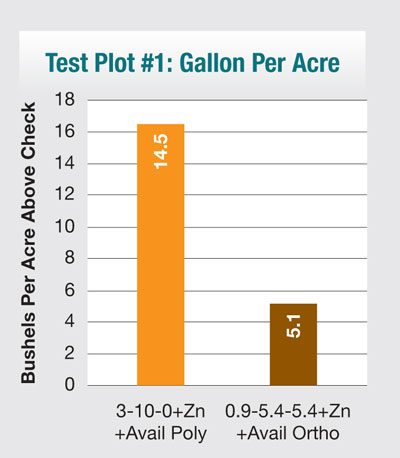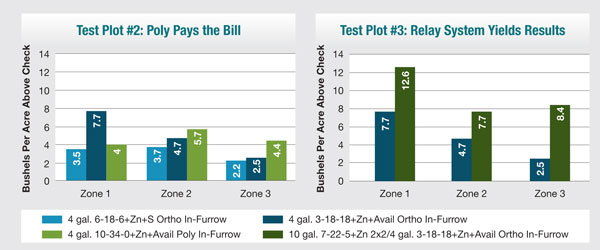Building on decades of starter fertilizer experience and knowledge, agronomist Ken Ferrie took his research a step further to learn more about phosphorus’s role in starter fertilizer blends, particularly as applied in corn.
Before we explore the data, let’s review the two sources of phosphorus in starter fertilizer. Polyphosphates are orthophosphate molecules joined together in the manufacturing process by heat and water removal. Poly fertilizers have a higher analysis compared with the ortho form. When added to the soil, the poly fertilizer combines with water to break down; the ortho fertilizer is readily absorbed by the plant.
Test Plot 1
To analyze the data, Ferrie and his crew measured starter fertilizer on a gallon-per-acre basis. In central Illinois, they compared 3 gallons of 10-34-0 Zn Avail (poly) to 3 gallons of 3-18-18 Zn Avail (ortho). That breaks down to 3-10-0 Zn Avail and 0.9-5.4-5.4 Zn Avail per acre.
“This is where it’s easy to get confused,” Ferrie says. “If you applied 3 gallons of 3-18-18, this does not mean you applied 54 pounds of phosphorus in your starter fertilizer.”
 The 3-10-0 Zn Avail (poly) yielded 16 bushels more than the check. The 0.9-5.4-5.4 Zn Avail (ortho) application yielded 5 bushels better than the check. As shown on the chart at right, the additional 5 pounds per acre of phosphorus in the poly fertilizer resulted in an additional 10-bushel-per-acre gain compared with the ortho fertilizer. This yield response is directly correlated to the pounds of phosphorus applied.
The 3-10-0 Zn Avail (poly) yielded 16 bushels more than the check. The 0.9-5.4-5.4 Zn Avail (ortho) application yielded 5 bushels better than the check. As shown on the chart at right, the additional 5 pounds per acre of phosphorus in the poly fertilizer resulted in an additional 10-bushel-per-acre gain compared with the ortho fertilizer. This yield response is directly correlated to the pounds of phosphorus applied.
In addition, Ferrie also evaluated starter response to phosphorus rates and placement. As a rule of thumb, data shows plants directly respond to applied phosphate. Therefore, the higher amount of phosphate applied closer to the seed, the higher the response. These findings often spur debates regarding ortho versus poly starter fertilizers.
When applying starter in-furrow, don’t forget about the risk of starter burn, Ferrie cautions. To avoid starter burn, limit in-furrow rates to reduce the potential harm from applying too much salt around the seed, which can affect germination and ear count in corn. Typically, Ferrie recommends a 10-34-0 poly starter fertilizer to avoid starter burn (no potash).
However, if a growers wants potash in his or her blend, ortho starter fertilizers have the potential to shine. These blends use potassium hydroxide, which is not a salt, so it’s considered safer and allows for higher rates in-furrow. However, using an ortho starter fertilizer does not guarantee avoidance of starter burn, Ferrie adds.
“Orthophosphate starter fertilizers do open the door to new possibilities in-furrow,” Ferrie says. “But you have to make sure the jump in fertilizer costs can be made up in yield.”
Test Plot 2
Ferrie also studied three in-furrow applications: 4 gallons of 6-18-6 Zn Sulfur (ortho), 4 gallons of 3-18-18 Zn Avail  (ortho), and 4 gallons of 10-34-0 Zn Avail (poly). As shown in the chart at right, averaged across all management zones, the first (ortho) application yielded 3.1 bushels more than the check, the second (ortho) received a 4.9-bushel gain, and the third (poly) had a 4.7-bushel response. On average, the poly fertilizer was the only application to pay the fertilizer bill.
(ortho), and 4 gallons of 10-34-0 Zn Avail (poly). As shown in the chart at right, averaged across all management zones, the first (ortho) application yielded 3.1 bushels more than the check, the second (ortho) received a 4.9-bushel gain, and the third (poly) had a 4.7-bushel response. On average, the poly fertilizer was the only application to pay the fertilizer bill.
Ortho fertilizers are worth the extra cost if purchasing a quality 10-34-0 poly starter fertilizer isn’t possible in a particular area. Because ortho costs twice as much as poly, it’s also a good idea to know your ROI for using one fertilizer versus the other.
A good, clean 10-34-0 poly starter fertilizer should be green with no sediment or offensive smell, Ferrie says.
Across all starter fertilizer plots in central Illinois, yield data consistently shows the direct correlation to starter response and pounds of phosphorus applied. The higher amount of phosphate applied closer to the plant, the higher the response. These test plots’ data suggest higher rates in starter placed 2 inches to the side and 2 inches down (2 × 2)from the surface can yield more than low rates in-furrow.
On average, past data shows there’s a 3- to 5-bushel response to in-furrow applications and a 7- to 10-bushel response to 2 × 2 applications.
“Due to starter attachment costs, many farmers only apply starter fertilizer in-furrow, which works,” Ferrie says. “However, by only applying in-furrow at a lower rate, you’re admitting on the front end your responses will be lower.”
In this case, Ferrie recommends using the highest rate possible (whether that be a poly or ortho starter fertilizer) to achieve enough yield response to pay the bill but not burn the seed. However, in 2 × 2 applications, Ferrie says the economical choice is a poly starter fertilizer with potash.
“If you’re applying 2 × 2, you don’t have to play it as safe as in-furrow,” Ferrie says. “Therefore, using a polyphosphate blend such as 7-22-5 or 6-18-6 will help you achieve a higher yield response at less cost.”
Test Plot 3
To take the results a step further, Ferrie also evaluated the relay effect. In his past test plots, dual placement has shown a 15- to 20-bushel yield increase. In 2016, the crew evaluated 4 gallons of 3-18-18 Zn Avail ortho in-furrow as well as 10 gallons of 7-22-5 Zn 2 × 2 and 4 gallons of 3-18-18 Zn Avail ortho in-furrow. The in-furrow application had an average 5-bushel increase, and the relay effect boosted yield by 10 bushels per acre.
“Once again, you can see the power of the relay effect,” Ferrie says. “It’s like the fertilizer placements hand off a baton, so the roots find the nutrients as they need them.”
When you adjust the phosphate amount in your starter fertilizer blend, don’t forget to reduce the amount in other applications to maintain your total goal, Ferrie says. For example, if you apply 10 gallons of 7-22-5, you will need to pull back 50 pounds of DAP.
Regardless of the placements or blends, it’s essential to consider the economics of starter fertilizer in all situations. Choose the combination that best fits your yield goal, soil types and pocketbook.
Source: Farm Journal